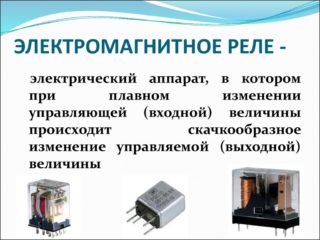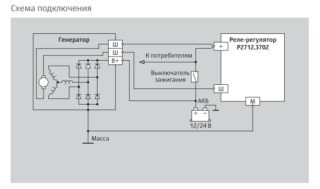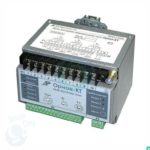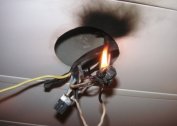A relay is a device designed to control high power signals using low power signals. Its main task is to separate and protect the low voltage circuit with an electromagnetic coil from the high voltage circuit. There are several ways to verify the operability of the relay, the most convenient, fast and reliable is the use of a multimeter.
Design and principle of operation of the switching device
An electrical relay is a part that is used as a switch thanks to the control signals that come to it through an electrical circuit. The line that is connected to the device is called managed; the line along which the command is already coming to him - the manager.
It is used in domestic conditions and in all industries in order to automate various operations. If a household or electrical appliance fails, the first step is to check the operability of the switching element. But it is recommended that you first familiarize yourself with the varieties and the principle of operation of the relay.
Principle of operation
 The part is an electromagnet, which includes an inductor, an armature and a contact group. Each component is mounted on the base and is enclosed in a protective housing.
The part is an electromagnet, which includes an inductor, an armature and a contact group. Each component is mounted on the base and is enclosed in a protective housing.
The anchor is located on top of the core of the magnetic system; in the initial position, it is held by a spring, which has the shape of a L-shaped movable plate.
The lower part of the base is equipped with a contact group; on the contrary, the same number of contact bases is mounted. The contacts are plastic because they need to be led outside the protective housing to form the output of the device.
The principle of operation of the relay is based on its ability to act on conductive objects with its electromagnetic field. As soon as voltage begins to be applied to the winding terminals, current flows through the relay. When its value reaches a previously programmed value, two forces are formed in the winding that press the armature to the surface of the coil.
Given the design features, the initial position can be not only closed, but also open. In the second case, when the voltage is applied, the line will open. The contacts of the device will return to their original state as soon as the signal of the required value is removed from the relay terminals.
Types and characteristics
Depending on the element base used, the relay controllers are divided into the following types:
- Microcontroller or microprocessor. Their peculiarity lies in laying in the integrated microcircuit a working algorithm. Used in expensive cars such as BMW or Audi.
- Relay relays are based on switching relay contacts to cut off and stabilize the performance of the electrical network.
- Integrated relays are widely used in the automotive industry. The principle of operation is based on solid-state switching parts or integrated semiconductor components.
- Hybrid transistor-relay devices and simply transistor based on semiconductor elements. Actively used in industry until the early 90s.
- Integrated relay
- Microprocessor relay
According to the design, they are divided into the following types:
- External relays are separate devices that are installed on body structures.
- Built-in switching parts are an integral part of generators.
- Combined or hybrid. Their peculiarity lies in combining with the brush assembly of an electric generator.
The electric relay can be two-, three- and multi-level, divided by "+" and "-".
Symptoms
Before checking the relay with a multimeter, you should familiarize yourself with the main signs that the part has failed.
- There are cases when, as a result of the failure of the voltage regulator, the battery begins to boil.
- When the ignition is switched on, the control lamp does not light up on the dashboard (however, this may be a symptom of other types of malfunctions, for example, a contact has fallen off or burned out).
- The dynamic characteristics of a household appliance or car are reduced, especially when the engine is gaining high speed.
- After starting, the battery indicator does not go out on the dashboard, which indicates a battery malfunction.
- The indicators on the dashboard simply turn off if the engine speed during operation exceeds 2000 rpm.
- The brightness of the headlights depends on the number of revolutions of the engine. To make sure of this is quite simple - it is necessary in the dark to stand in front of the wall and turn on the lights. The brightness of the glow will vary depending on how much you press on the gas.
- The battery is regularly discharged.
These symptoms may indicate other malfunctions, but first of all, it is recommended to check the relay regulator.
Reasons for the failure of the relay controller
 In order to minimize the likelihood of repeated failures in the future, you should familiarize yourself with the main reasons for the failure of the device.
In order to minimize the likelihood of repeated failures in the future, you should familiarize yourself with the main reasons for the failure of the device.
- Short circuit in any of the sections of the electrical circuit, including inter-turn circuit of the field winding.
- The regulator may also fail in the event of a breakdown of the diodes or a breakdown of the rectifier bridge.
- Incorrect connection or reconnection to battery terminals.
- Penetration of moisture or large amounts of dust into the generator and / or directly the regulator (such cases are common during heavy rainfall or when washing the machine).
- Mechanical damage to the work unit.
- Natural wear and tear, end of life.
- Initially, the dubious quality of the purchased goods.
There are several simple ways to ring built-in and removable relays.
Preparing to test relay operation
 Checking the relay will not take much time if all the preparatory work is done correctly.
Checking the relay will not take much time if all the preparatory work is done correctly.
Before proceeding with the diagnosis of the device, it is necessary to determine the purpose of the conclusions of the tested part. To do this, use the attached documentation for the device, it contains all the schemes and features of the work, the characteristics of the device.
Cases are common when the operation diagram is depicted on the relay case itself. The dots represent the contacts, they are connected by an inductor, switching elements in straight lines with a dotted line. The terminals for power supply are schematically shown as a rectangle.
If the relay is built into the circuit, the board itself needs to visually inspect the status of the bus and the power path. To test the relay with a tester, you can use both digital and analog devices. Preliminary preparation and setup of testers is not required.
In addition to the tester, it is necessary to prepare an adjustable power supply. In order for the results to be reliable, the relay must be removed from the circuit.
Performance check is carried out in several stages:
- winding;
- normally closed position;
- normally open state.
Then you can proceed directly to the diagnosis of the relay.
Diagnostics of windings and contact groups
 The winding is an inductor on which a wire is wound in a spiral. She is characterized by a certain resistance, which is calculated according to Ohm's law. The resistance value should fluctuate between 10 - 100 Ohms.
The winding is an inductor on which a wire is wound in a spiral. She is characterized by a certain resistance, which is calculated according to Ohm's law. The resistance value should fluctuate between 10 - 100 Ohms.
Diagnostics of the winding allows you to find out if its integrity is broken. The performance check is carried out in several stages:
- The multimeter is turned on in the resistance dialing mode. On the instrument panel, this mode is indicated by the symbol - Ω, the range is set within 2 kOhm.
- One test lead is led to the socket, and the second to COM.
- The probes touch the relay terminals.
The resistance of the inductor can be found by the deviation of the arrow.
Checking contact groups is carried out in two stages. First, resistance is necessarily measured in stand-alone mode, and then when voltage is applied to the coil. When checking, you will need a power source, you need to take care of this in advance.
Abnormal voltage values on the multimeter
If the multimeter shows a low voltage in the battery, the battery will simply stop taking charge. As a result, the car may not start, the indicators on the dashboard may stop working, and troubles can also occur while driving.
If the voltage is increased, there is a chance that the electrolyte level in the battery bank has decreased, or it simply boiled away. Also, a characteristic feature may be the formation of white plaque on the walls of the body. When recharging, the battery may begin to behave unpredictably.






